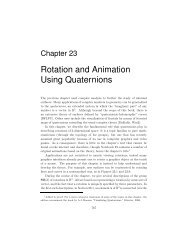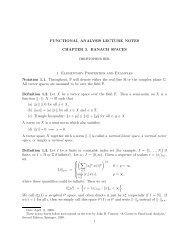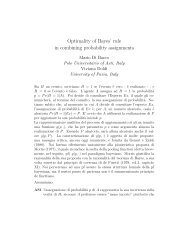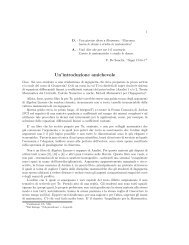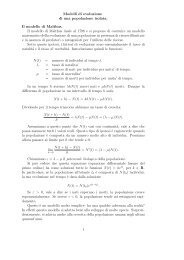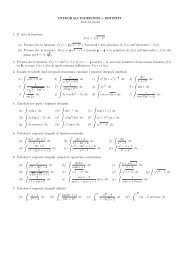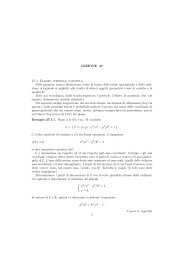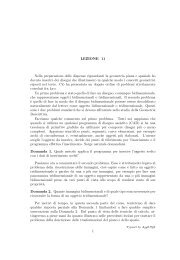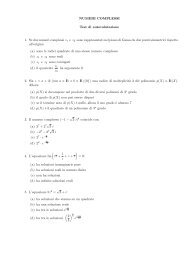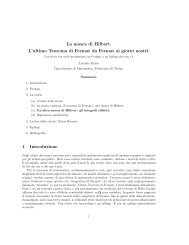j - Dipartimento di Matematica - Politecnico di Torino
j - Dipartimento di Matematica - Politecnico di Torino
j - Dipartimento di Matematica - Politecnico di Torino
You also want an ePaper? Increase the reach of your titles
YUMPU automatically turns print PDFs into web optimized ePapers that Google loves.
hard copy ISSN 1974-3041<br />
on-line ISSN 1974-305X<br />
La <strong>Matematica</strong><br />
e le sue Applicazioni<br />
n. 11, 2010<br />
A mathematical procedure for the evolution of future<br />
landscape scenarios<br />
F. Gobattoni, G. Lauro, A. Leone, R. Monaco, R. Pelorosso<br />
Quaderni del<br />
<strong>Dipartimento</strong> <strong>di</strong> <strong>Matematica</strong><br />
<strong>Politecnico</strong> <strong>di</strong> <strong>Torino</strong><br />
Corso Duca degli Abruzzi, 24 – 10129 <strong>Torino</strong> – Italia
E<strong>di</strong>zioni C.L.U.T. - <strong>Torino</strong><br />
Corso Duca degli Abruzzi, 24<br />
10129 <strong>Torino</strong><br />
Tel. 011 564 79 80 - Fax. 011 54 21 92<br />
La <strong>Matematica</strong> e le sue Applicazioni<br />
hard copy ISSN 1974-3041<br />
on-line ISSN 1974-305X<br />
Direttore: Clau<strong>di</strong>o Canuto<br />
Comitato e<strong>di</strong>toriale: N. Bellomo, C. Canuto, G. Casnati, M. Gasparini, R. Monaco,<br />
G. Monegato, L. Pandolfi, G. Pistone, S. Salamon, E. Serra, A. Tabacco<br />
Esemplare fuori commercio<br />
accettato nel mese <strong>di</strong> Ottobre 2010
A mathematical procedure for the evolution of future landscape scenarios.<br />
Authors: F. Gobattoni 1 , G. Lauro 2 , A. Leone 1 , R. Monaco 3 , R. Pelorosso 1<br />
1 Department of Environment and Forestry, University of Tuscia, Viterbo (Italy)<br />
2 Architecture Faculty, Second University of Naples, 81031 Aversa, (Italy)<br />
3 Department of Mathematics, <strong>Politecnico</strong> <strong>di</strong> <strong>Torino</strong>, <strong>Torino</strong> (Italy)<br />
Correspon<strong>di</strong>ng author: f.gobattoni@unitus.it<br />
Introduction<br />
Since the European Landscape Convention aims to encourage all European countries to define their<br />
landscape quality objectives, a new frame of mind in management and planning of territory is<br />
nowadays required as a point of reference for territorial government, entities and authorities, so as<br />
to advance towards conservation and protection of landscapes provi<strong>di</strong>ng positive impact on the<br />
quality of life of population. Moreover, planning efficiently at the landscape scale needs a crosssector<br />
cooperation and people involvement with planners and communities working closely in<br />
achieving positive landscape change understan<strong>di</strong>ng and in characterizing the relations between<br />
nature and society, which will integrate landscapes and their dynamics. (C. Petit et al., 2008).<br />
The methodologies for successful landscape and environmental planning have been severely<br />
challenged when classical concepts and models such as economic and socioeconomic development,<br />
ecosystems preservation and sustainability have been questioned (J. E. Vermaat et al., 2005). The<br />
actual challenge is to build transparent and flexible decision-making tools to be used in<br />
environmental planning and to embrace a broad range of stakeholders needs together with<br />
landscape management requirements.<br />
Landscape-scale geographical information provides an ideal framework for developing spatial<br />
strategies and to implement simulation models to support landscape planning identifying<br />
opportunities for change and anticipating and comparing the results of planning decisions. Model<br />
outputs can be used to elaborate thematic maps and visualizations of landscape scenarios as an<br />
effective and <strong>di</strong>rect way of communicating results and opportunities.<br />
In this framework, landscapes can be defined as spatially extended heterogenous complex systems<br />
organized hierarchically into structural arrangements determined by nonlinear interactions among<br />
their components through flows of energy and materials (we shall use the overall term "bio-energy"<br />
as introduced by Ingegnoli, 2002 ). Human activity has, also, strongly mo<strong>di</strong>fied recent landscape by<br />
means of land use and land cover changes and consuming of natural resources (Pelorosso et al.,<br />
2009). Alterations of natural equilibriums has pointed out several consequences on landscape<br />
capacity to furnish goods and service (Willemen et al, 2008) as bio<strong>di</strong>versity conservation<br />
(Tscharntke et al., 2005) and regulation of water regimes (Lindborg et al., 2008).<br />
Environmental available energy has been pointed out as a key factor in the explanation of many<br />
ecological processes and theories (metabolic and species energy theory, bio<strong>di</strong>versity conservation)<br />
recurring to <strong>di</strong>fferent indeces (e.g. Net Primary Productivity, NNP, Actual Evapotraspiration, AET,<br />
Potential Evapotraspiration, PET) (Hurlbert and Jetz, 2010; Currie, 1991; Carrara et al. 2010;<br />
Brown at al., 2004). A more complete measure of available energy, so-called Biological Territorial<br />
Capacity (BTC), was proposed by Ingegnoli (2002) considering a synthetic function of vegetation<br />
metabolism. As the importance of energy exchange, although it is rare for a landscape to be in any<br />
form of equilibrium and the landscape equilibrium concept is not yet clear (Perry, 2002; Turner et<br />
al., 1993; Bracken and Wainwright, 2006), it’s interesting to focus on which hypothetical energetic<br />
equilibrium state is going to be realized and the effects of human decisions on that equilibrium.<br />
Most of mathematical models are strictly related to air <strong>di</strong>spersion, hydrology and hydrodynamics,<br />
water quality, ground water quality, erosion and se<strong>di</strong>mentation, and so on, just taking into account<br />
each aspect of the environmental system separately and without looking <strong>di</strong>rectly at landscape as a
unique system and without understan<strong>di</strong>ng its intrinsic evolution mechanisms. All decision making<br />
involves an implicit (if not explicit) use of models, since the decision maker invariably has a causal<br />
relationship in mind when he makes a decision. So mathematical models able to explain the<br />
landscape evolution and to compare the effects of future scenarios on its evolution and equilibrium<br />
in time, are really needed not also to understand environmental system mechanism and behaviour<br />
but above all to better plan strategies for natural resources conservation management and landscape<br />
preservation.<br />
The environment is here considered as composed by several Landscape Units (LU) delimited by<br />
natural and/or anthropic barriers. An integrated GIS (Geographic Information System)-based<br />
approach was developed (G. Lauro, R. Monaco, 2008) combining an ecological graph model for the<br />
analysis of the relationship between spatial pattern and ecological fluxes and a mathematical model,<br />
based on a system of two nonlinear <strong>di</strong>fferential equations. These equations are mainly based on a<br />
balance law between a logistic growth of bio-energy and its reduction due to limiting factors<br />
coming from environmental constraints. The energy exchange among them will be more or less<br />
strong depen<strong>di</strong>ng on the degree of permeability of the barriers which can obstruct the energy<br />
passage from each LU to the other.<br />
A GIS-based mathematical model, based on the ecological graph and on the cited two <strong>di</strong>fferential<br />
equations, is presented and <strong>di</strong>scussed here. A study case in Central Italy is introduced and <strong>di</strong>scussed<br />
here just to show the importance of a such mathematical procedure to figure out planning strategies<br />
and environmental conservation and management actions with the support of rigorous methods able<br />
to fix and compare the effects of anthropic decisions on landscape.<br />
Study area description<br />
The study area (Fig. 1) for the model development, is Traponzo River catchment; Traponzo River is<br />
located in the northern part of Lazio Region and its watershed covers part of nine municipalities,<br />
lying completely in the Province of Viterbo.<br />
This stream originates in Monti Cimini relief and flows into Marta river so that Traponzo<br />
catchment, as a sub-basin of Marta river, has a total area of 475 Km 2 , with a mean elevation of 526<br />
m a.s.l. and a maximum of 979 m a.s.l.. The climate of this area is quite Me<strong>di</strong>terranean with a mean<br />
annual temperature of about 15°C and a mean annual precipitation of about 970 mm. The total area<br />
covered by urban sprawl is about 2.23 km 2 that is about 10% of the total urban area.<br />
Land cover class Area (km 2 ) %<br />
Urban 21.02 4.4<br />
Forest 126.36 26.6<br />
Non irrigated crops 203.04 42.8<br />
Pasture 22.01 4.6<br />
Orchards 88.17 18.6<br />
Irrigated crops 2.49 0.5<br />
Hedges 11.77 2.5<br />
Water bo<strong>di</strong>es 0.02 0<br />
Total area 474.89 100<br />
Table 1.
Fig.1. Study area
Model description and methodologies<br />
Gathering all the available information on the climatic, topographic, land cover, geological and<br />
pedological characteristics describing our study area, a GIS dataset has been created not only to<br />
represent the watershed but also to identify and derive the LU structure. Taking into account urban<br />
areas <strong>di</strong>stribution, primary and secondary roads network, soil features and elevation and weighting<br />
them through the application of Saaty matrix, a standard heuristic methodology has been fixed to<br />
split the study area into well defined LU. A number of 46 LU has been derived for this study area<br />
and an ecological graph for representing the energy flows between them has been elaborated taking<br />
into account the Biological Territorial Capacity (BTC) proposed by Ingegnoli (2002). The<br />
ecological graph, at first introduced by Fabbri (2003), has been applied here to quantify and<br />
correlate the energy production from a landscape unit as a flow of energy to its neighbours<br />
accor<strong>di</strong>ng to the permeability of the boundaries.<br />
The study area GIS dataset also allow to set up all the parameters needed to run the mathematical<br />
model structured as follows.<br />
It consists in two or<strong>di</strong>nary <strong>di</strong>fferential equations, of evolution in time, of the following two state<br />
variables, M(t) and V(t) :<br />
1) M(t), the mean value of the biological energy of the whole system, t being the time, given by<br />
m<br />
1<br />
M ( t)<br />
= ∑ M j<br />
, M j = (1 + Kj)Bj (1), (2)<br />
m<br />
j=<br />
1<br />
where Bj is an index measuring the BTC of the j LU, that is the magnitude representing the energy<br />
(Mcal/m 2 /year) that system needs to <strong>di</strong>ssipate in order to maintain its equilibrium state and its<br />
organizational level, and where the parameter Kj depends on several properties related to unit’s<br />
composition. In particular, in this paper we shall consider that it depends on 5 features and it is<br />
given by<br />
F P D C E<br />
K = ( K + K + K + K + K ) / 5<br />
(3)<br />
j<br />
where<br />
j<br />
j<br />
j<br />
j<br />
j<br />
F<br />
K<br />
j<br />
takes into account the shape of the patch borders,<br />
P<br />
K<br />
j<br />
their permeability,<br />
D<br />
K<br />
j<br />
the bio-<br />
C<br />
E<br />
<strong>di</strong>versity of the LU. The last two parameters K<br />
j<br />
and K<br />
j<br />
are related, respectively, to the relative<br />
humi<strong>di</strong>ty of the soil and to the sun exposition of the LU, and are introduced for the first time in this<br />
paper. We recall that all these parameters are defined in such a way that K ∈ [0; 1].<br />
For the computation of the parameters<br />
Conversely<br />
K<br />
C<br />
j<br />
w1<br />
A<br />
=<br />
h<br />
j<br />
C<br />
K<br />
j<br />
and<br />
+ w<br />
A<br />
j<br />
2<br />
A<br />
s<br />
j<br />
F<br />
K<br />
j<br />
,<br />
P<br />
K<br />
j<br />
and<br />
E<br />
K<br />
j<br />
are defined by the following formulae:<br />
, K<br />
where the w k are suitable weights,<br />
E<br />
j<br />
SWE W<br />
3<br />
Aj<br />
+ w4<br />
Aj<br />
+<br />
j<br />
D<br />
K<br />
j<br />
, see Finotto et al. (2010).<br />
NE<br />
w<br />
w5<br />
Aj<br />
= (4), (5)<br />
A<br />
Aj<br />
is the total area of the j LU, and<br />
j<br />
h s<br />
A<br />
j<br />
, A<br />
j<br />
,<br />
SWE<br />
A<br />
j<br />
,<br />
W<br />
A<br />
j<br />
,<br />
are the fractions of soil surfaces characterized by humi<strong>di</strong>ty, sub-humi<strong>di</strong>ty, south-west-east, west and<br />
north-west exposition.<br />
Moreover:<br />
M = , B max { B }<br />
max<br />
2B max<br />
max<br />
= (6), (7)<br />
j=<br />
1,...., m<br />
j<br />
NE<br />
A<br />
j
in other words M max is the maximum value of biological energy that the environment under<br />
consideration can exhibit accor<strong>di</strong>ng to the maximum value of bio-potentiality expressed by the m<br />
<strong>di</strong>fferent LU. These last definitions lead to fix the bio-potentiality index as<br />
B<br />
b T<br />
= (8)<br />
B max<br />
which, thus, turns out to be confined in the range [0; 1].<br />
2) V (t), the fraction of the total territory’s surface occupied by areas characterized by high values<br />
of Bj ( high values correspond, for example, to wooden areas).<br />
The proposed equations read :<br />
' ⎡ M ( t)<br />
⎤<br />
M ( t)<br />
= cM ( t)<br />
⎢1<br />
− − k[ 1 −V<br />
( t)<br />
] M ( t),<br />
M<br />
⎥<br />
(9)<br />
⎣ max ⎦<br />
[ 1 −V<br />
( t)<br />
] h U V ( ),<br />
V ' ( t)<br />
= bTV<br />
( t)<br />
−<br />
0 0<br />
t<br />
(10)<br />
They read as a balance law between a logistic growth of bio-energy M (t) and its reduction due to<br />
limiting factors coming from environmental constraints expressed by the coefficients c, k, b T , h,<br />
Uo.<br />
Having already given the definition of b T , we now proceed to deal with the other parameters.<br />
c∈ [0; 1] is the connectivity index which is a function of the energy fluxes F ij between each pair of<br />
confining LU, namely<br />
S S<br />
Mi<br />
+ M<br />
j<br />
Fij<br />
=<br />
2<br />
Lij<br />
⋅ ⋅ p<br />
P + P<br />
i<br />
j<br />
(11)<br />
L ij being the length of the boundary between the i and j LU; P i and P j being their perimeters, while<br />
p is the permeability index of such a boundary. Moreover k is the ratio between the sum of the<br />
perimeters of the impermeable barriers and the perimeter of the whole environment. h is another<br />
environment impact parameter defined as the ratio between the sum of the e<strong>di</strong>fied areas perimeter<br />
(both compact and spread) and the total perimeter P of the whole environment. Finally U 0 ∈ [0; 1]<br />
is the ratio between the surface of the e<strong>di</strong>fied areas and the total area S of the system. U 0 will be<br />
computed as the weighted average:<br />
U<br />
0<br />
w6U<br />
c<br />
+ w7U<br />
s<br />
= (12)<br />
S<br />
where U c and U s are the surface fractions of compact and spread e<strong>di</strong>fied areas, and w 6 , w 7 suitable<br />
weights. Note that conversely to the other parameters of the model, k and h may assume values<br />
greater than one (Finotto et al., 2010).<br />
In order to get a detailed evolution of the environment, one can integrate the equations (9-10) from<br />
suitable initial data M(0) and V(0) which can be recovered by the ecological graph. The model<br />
provide these scenarios correspon<strong>di</strong>ng to the following four equilibrium solutions of the <strong>di</strong>fferential<br />
equation system:
(1)<br />
(1)<br />
(a) M = 0 ; V = 0<br />
(2)<br />
(b) M = 0 ;<br />
( 2) bT<br />
− hU<br />
0<br />
V<br />
=<br />
b<br />
T<br />
(c)<br />
(d)<br />
M<br />
M<br />
M<br />
max<br />
( c k)<br />
(3)<br />
= , V = 0<br />
c<br />
( 3) −<br />
(4)<br />
=<br />
M<br />
max<br />
[ c − k( 1 −V<br />
)]<br />
c<br />
e<br />
,<br />
b<br />
=<br />
hU<br />
b<br />
( 4) T<br />
−<br />
0<br />
V<br />
T<br />
As it can be easily understood the first equilibrium is quite negative since it prevents an<br />
environment where production and <strong>di</strong>ffusion of biological energy is negligible and no areas of high<br />
ecological quality are present. The second scenario is that of a territory strongly fragmented where<br />
<strong>di</strong>ffusion of biological energy between the LU is again negligible but some area of high quality<br />
vegetation is still present. The third equilibrium corresponds to a territory characterized by some<br />
production and <strong>di</strong>ffusion of bio-energy but low vegetation quality. Finally the last scenario is that<br />
more favourable since strong production and <strong>di</strong>ffusion of biological energy between the LU allows<br />
to guarantee an ecological settlement of high level of bio-potentiality. The stability analysis (Finotto<br />
et al., 2010) has shown that the above equilibrium solutions can be obtained, respectively, when the<br />
model parameters satisfy the following inequalities:<br />
c < k and b T<br />
< hU<br />
0<br />
(I)<br />
khU<br />
0<br />
> cb T<br />
and b T<br />
> hU<br />
0<br />
(II)<br />
c > k and b T<br />
< hU<br />
0<br />
(III)<br />
khU<br />
0<br />
> cb T<br />
and b T<br />
> hU<br />
0<br />
(IV)<br />
The ecological graph representation together with the solutions of the mathematical procedure can<br />
be derived through a NetLogo model application that give us an easy tool to model the equilibrium<br />
states of landscape evolution starting from the initial, actual con<strong>di</strong>tions as described by the<br />
ecological graph itself (Gobattoni F. et al., 2010).<br />
Results and <strong>di</strong>scussion<br />
As an assessment of the ecological behaviour for an environment, the ecological graph assigns a<br />
node <strong>di</strong>mension proportional to the available energy and a link between LU with a <strong>di</strong>mension<br />
proportional to the flux of energy. The energy exchange among them will be more or less strong<br />
depen<strong>di</strong>ng on the degree of permeability of the barriers which can obstruct the energy passage from<br />
each LU to the other.
Fig. 2 Ecological graph representation for the study area.
Applying the proposed LU identification methodology and deriving all the required parameters<br />
needed to set up the mathematical model, this summarizing table can be obtained:<br />
Total area (km 2 ) 475<br />
High bio-potentiality area (km 2 ) 124<br />
V 0 0.26<br />
b T 0.1606<br />
M max (Mcal/m 2 /year) 2.3 E+08<br />
B max (Mcal/m 2 /year) 1.5 E+08<br />
U 0 0.02<br />
h 1.96<br />
k 0.75<br />
c 0.0374<br />
V e 0.72<br />
M e 0<br />
Table 2.<br />
The values in Table 2, have been entered in NetLogo model elaborating the proposed <strong>di</strong>fferential<br />
system. In particular, b<br />
T<br />
, h, U<br />
0<br />
, M max , k and c seems to satisfy the inequality (II) so that the<br />
equilibrium correspon<strong>di</strong>ng to he second scenario turns out to be stable and the system evolves<br />
asymptotically to this equilibrium state. The system tends to keep areas with high value of biopotentiality<br />
but they are isolated in landscape pattern and the fluxes of bio-energy between them<br />
seem to be limited. As a consequence, the dynamic evolution of this environmental system shows a<br />
trend toward a good production of bio-energy but with a limited <strong>di</strong>ffusion of it, and, then, with<br />
limited fluxes between LU. A low connectivity index (Table 2), <strong>di</strong>scloses to this equilibrium state<br />
as a solution of the <strong>di</strong>fferential equations system, since the lack of connectivity preju<strong>di</strong>ces the<br />
energy exchange between LU even containing high BTC values areas. The landscape fragmentation<br />
provoked by a large urban sprawl phenomenon and by the rich and structured roads network is<br />
reflected on the confined and obstructed energy fluxes between LU. The need of opportune<br />
planning strategies and actions to reduce fragmentation favouring the energy fluxes between<br />
ecosystems and preserving bio<strong>di</strong>versity, has to be underlined since the actual landscape pattern for<br />
the study area shows a low response in terms of connectivity and energy fluxes.<br />
Conclusions<br />
If the ecological graph is a powerful tool to represent connections efficiency between LU and to<br />
identify high ecological values areas to be protected and compromised ones limiting energy fluxes,<br />
on the other side a mathematical model evaluating the potential effectiveness of natural resources<br />
on the long term, is essential to assess the <strong>di</strong>achronic evolution of landscape as a unique system.<br />
An integrated approach combining the ecological graph and the mathematical model, allows to face<br />
the great challenge of planning and management under sustainable environmental and economical<br />
con<strong>di</strong>tions since it can represent a powerful decision system support to compare effects and impacts<br />
of alternative scenarios and actions (evaluation of new roads and urban development plans).<br />
Not only for a description of the available energy at LU scale but also as a tool for evaluating the<br />
equilibrium trend in landscape evolution, this mathematical and GIS interfaced method can help in<br />
understan<strong>di</strong>ng environment response and dynamic change in time to correctly manage and preserve<br />
natural resources and ecosystems.
References<br />
Bracken L. J and Wainwright J. 2006. Geomorphological equilibrium: myth and metaphor? Trans<br />
Inst Br Geogr, 31:167–178.<br />
Brown J. H., Gillooly J. F., Allen A. P., Savage V. M., West G. B. 2004. Toward a Metabolic<br />
Theory of Ecology. Ecology, 85(4):1771-1789.<br />
Carrara R. and Vàzquez D. P. 2010. The species energy theory: a role for energy variability.<br />
Ecography 000: 000000 doi: 10.1111/j.1600-0587.2009.05756.x.<br />
Currie D. J. 1991. Energy and large-scale patterns of Animal- and Plant-Species Richness. The<br />
American Naturalist, 137:27-49.<br />
Fabbri P., Paesaggio, Pianificazione, Sostenibilità, Alinea E<strong>di</strong>trice, Firenze 2003. Principi<br />
Ecologici per la Progettazione del Paesaggio, Franco Angeli, Milano 2007.<br />
Finotto F., Monaco R., Servente G., Un modello per la valutazione della produzione e della<br />
<strong>di</strong>ffusività <strong>di</strong> energia biologica in un sistema ambientale, to be printed on Scienze Regionali (Ital. J.<br />
of Regional Sci.), 2010.<br />
Forman R. T. T. 1995. Land Mosaics. The ecology of landscape and regions. Cambridge:<br />
Cambridge Press.<br />
Gobattoni F., Lauro G., Leone A., Monaco R., Pelorosso R., 2010. A simulation method for the<br />
stability analysis of landscape scenarios by using a NetLogo application in GIS environment. EGU<br />
Conference, 3-7 May, Vienna, Austria.<br />
Hurlbert A. H. and Jetz W. 2010. More than “More In<strong>di</strong>viduals”: The Non-equivalence of Area and<br />
Energy in the Scaling of Species Richness. Am Nat 2010. Vol. 176, pp. 000–000 DOI:<br />
10.1086/650723.<br />
Ingegnoli V. 2002. Landscape Ecology: A Widening Foundation. New York-Berlin: Springer-<br />
Verlag.<br />
Ingegnoli V., Forman R.F., 2002. Landscape Ecology: A Widening Foundation, Springer-Werlag,<br />
New York.<br />
Lauro G., Lisi M., Monaco R., 2008. Bifurcation analysis of a dynamical model for an ecological<br />
system. La <strong>Matematica</strong> e le sue Applicazioni, n. 15. on-line ISSN 1974-305X.<br />
Naveh Z., Liebermann A. 1984. Landscape ecology: theory and application. Springer-Werlag, New<br />
York.<br />
Pelorosso R., Leone A., Boccia L. 2009. Land cover and land use change in the Italian central<br />
Apennines: A comparison of assessment methods. Applied Geography 29:35–48.<br />
Perry L.W., 2002. Landscape, space and equilibrium: shifting viewpoints. Progress in Physical<br />
Geography, 26 (3):339-359.<br />
Petit C.et al., 2008. Landscape Analysis and Visualisation-Spatial Models for Natural Resources<br />
and Planning. Springer,<br />
Tscharntke T., Klein A. M., Kruess A., Steffan-Dewenter I.and Thies C. 2005. Landscape<br />
perspectives on agricultural intensification and bio<strong>di</strong>versity – ecosystem service management.<br />
Ecology Letters, 8 (8):857-874.<br />
Turner M. G., Romme W. H., Gardnerl R. H., O’Neill R. V. and Kratz T. K. 1993. A revised<br />
concept of landscape equilibrium: Disturbance and stability on scaled landscapes. Landscape<br />
Ecology, 8(3):213-227.<br />
Turner M.G., Gardner R.H., 1990. Quantitative methods in Landscape Ecology. Springer-Werlag,<br />
New York.<br />
Vermaat, J.E., Eppink, F., Van den Bergh, J.C.J.M., Barendregt, A. & Van Belle, J. 2005. Matching<br />
of scales in spatial economic and ecological analysis. Ecol. Econ., 52, 229-237.<br />
Willemen L., Verburg P.H., Hein L., Van Mensvoort M. E. F. (2008). Spatial characterization of<br />
landscape functions. Landscape and Urban Planning, 88:34-43.



